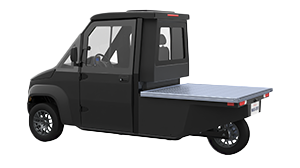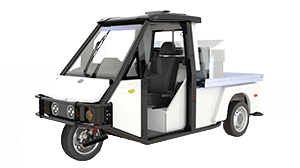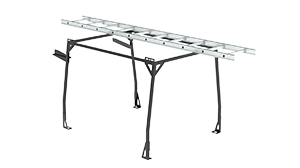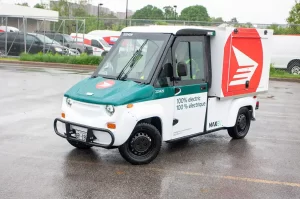The Need for Change: Why Cities are Switching to Electric Utility Vehicles
Cities around the world are facing mounting pressure to adopt more sustainable, cost-effective solutions for their municipal fleets. While the shift to electric utility vehicles is often discussed in terms of reducing emissions, the underlying financial and environmental factors driving this transformation are often less examined. Municipalities are being forced to rethink how they operate as they confront new environmental regulations and tighter budgets.
Environmental Regulations
As emission standards become more stringent, cities are being pushed to adopt cleaner technologies. Electric utility vehicles, such as Westward’s MAX-EV and GO-4 EV interceptor, align perfectly with these new regulations by offering zero tailpipe emissions. What many experts overlook is the pace at which cities are being required to meet these sustainability goals, leading to an accelerated timeline for replacing traditional gas-powered fleets.
Economic Pressures
Fuel prices and rising vehicle maintenance costs are also forcing cities to explore alternatives. Traditional fleets, with their high fuel consumption and frequent repairs, are becoming financially burdensome. What’s often not discussed is how cities are evaluating the total cost of ownership, leading them to consider electric vehicles not just for environmental reasons, but to achieve long-term cost savings as well. See our online fuel calculator here
Upfront Investment: Understanding the Costs of Electric Vehicles
Switching to electric utility vehicles requires an upfront investment, but the full scope of these costs is often misunderstood. While the initial purchase price of electric vehicles can seem higher than gas-powered alternatives, there are several overlooked factors that make this investment more manageable and worthwhile in the long run.
Initial Vehicle Cost
When discussing the initial cost of vehicles like the MAX-EV or GO-4 EV, it’s important to account for both the base model and optional upgrades. Features such as enhanced battery capacity or customizations for specific municipal needs can increase the upfront cost, but they also enhance operational efficiency. What many fail to consider is how these additional features lead to long-term savings in fuel, maintenance, and downtime.
Charging Infrastructure
One of the key investments is setting up the necessary charging infrastructure. Cities will need to evaluate the cost of installing Level 1 and Level 2 charging stations across municipal facilities. Although this may seem like a significant upfront expense, these stations can be designed for scalability, allowing cities to expand their charging capabilities over time as the fleet grows. All Westward Vehicles do work on 110v plugs as well as 220v, this versatility allows for less initial infrastructure demand.
Government Incentives
Many cities overlook the substantial financial support available through government incentives. Grants, tax credits, and rebates can significantly offset the initial investment, easing the financial burden on municipalities and making the transition to electric utility vehicles more accessible.
Long-Term Savings: Fuel and Maintenance Reduction
The real financial advantage of electric utility vehicles lies in their long-term savings. While the upfront costs may seem steep, cities often overlook how much they stand to save over time by switching to electric fleets. Traditional gas-powered vehicles come with a hefty price tag for both fuel and maintenance, two costs that electric vehicles dramatically reduce.
Fuel Savings
Electric vehicles eliminate the need for gasoline or diesel, a major source of ongoing expenses for municipalities. With fluctuating fuel prices and the ever-growing need to keep large fleets operational, switching to electric utility vehicles represents substantial savings. The cost per mile for electric vehicles is significantly lower, meaning that the more the vehicle is used, the greater the cumulative savings over time.
Lower Maintenance Costs
Another often-overlooked benefit is the lower maintenance requirement of electric vehicles. Traditional internal combustion engine vehicles come with complex engines, transmissions, and exhaust systems that need regular servicing. Typically these drivetrains contain thousands of parts. In contrast, electric vehicles like the MAX-EV Or the GO-4 EV, have fewer moving parts and rely on low-maintenance lithium-ion batteries, reducing downtime and repair costs. This results in less frequent repairs and more time spent on the road, enhancing operational efficiency for cities.
Operational Efficiency and Time Savings
Beyond fuel and maintenance savings, electric utility vehicles offer operational benefits that are often overlooked. These vehicles can greatly enhance day-to-day efficiency for city operations, reducing downtime and streamlining the fleet’s performance.
Reduced Refueling Time
Refueling gas-powered vehicles can be time-consuming, especially for large fleets. Electric vehicles eliminate this need by offering quick charging options, which can be done during non-operational hours or at designated charging stations. This reduces the downtime typically associated with refueling, keeping vehicles on the road for longer periods. With Level 2 charging, many electric utility vehicles can be charged quickly enough to meet the demands of city operations without major disruptions.
Improved Uptime with Remote Diagnostics
Another key advantage of electric vehicles is their ability to integrate remote diagnostics. Westward’s electric utility vehicles, such as the MAX-EV, offer real-time monitoring systems that detect and address issues before they become major problems. This capability minimizes vehicle downtime by allowing for proactive maintenance, ensuring that small issues can be addressed remotely or during scheduled downtime rather than leading to extended repairs. These advancements reduce interruptions in fleet operations and keep vehicles running efficiently.
Environmental and Health Benefits: Reducing Emissions in City Operations
One of the most compelling reasons cities are shifting to electric utility vehicles is the environmental and public health benefits. Traditional gas-powered vehicles are major contributors to urban air pollution, which directly impacts both the environment and residents’ health. Electric vehicles provide a cleaner alternative, helping cities achieve their sustainability goals while also promoting healthier living conditions.
Zero Tailpipe Emissions
Electric utility vehicles like the MAX-EV produce zero tailpipe emissions, which means they don’t release harmful pollutants such as carbon dioxide, nitrogen oxides, or particulate matter. By reducing these emissions, cities can significantly lower their overall carbon footprint and improve air quality. This is especially important in densely populated urban areas where traffic-related emissions are a major concern.
Improved Public Health
Reducing vehicle emissions has a direct impact on public health. Cleaner air means fewer respiratory issues for city residents, particularly vulnerable populations such as children and the elderly. Electric vehicles help lower the rates of air-pollution-related diseases, including asthma and other chronic respiratory conditions. By adopting electric fleets, cities are investing in the long-term health of their communities while simultaneously meeting their environmental goals.
Enhanced Versatility: Meeting the Diverse Needs of Municipal Fleets
Electric utility vehicles are not only environmentally friendly but also highly adaptable to a range of municipal tasks. What many overlook is how customizable these vehicles can be, making them an ideal solution for cities that require versatility in their fleet.
Customizable Options
Electric vehicles like Westward’s MAX-EV can be outfitted with a variety of custom accessories to meet specific operational needs. This flexibility allows municipalities to use the same vehicle for different tasks, optimizing fleet efficiency. Some customizable features include:
- Tilting beds for easy loading and unloading of materials in maintenance or landscaping tasks.
- Tow hitches for transporting equipment or additional vehicles.
- Van bodies for enclosed cargo storage, perfect for sensitive or valuable items.
Multi-Tasking Capabilities
These vehicles aren’t limited to a single function. They can easily transition between roles, making them suitable for:
- Street maintenance and landscaping crews.
- Parking enforcement tasks, where compact, efficient vehicles are necessary.
- Public safety tasks, supporting quick response times and operational efficiency.
Electric utility vehicles can handle a wide range of city functions, providing maximum value and flexibility for municipal fleets.
Infrastructure Considerations: Power and Charging Needs
One of the key factors for municipalities transitioning to electric utility vehicles is understanding the infrastructure requirements to support a fully electric fleet. Beyond the vehicles themselves, cities need to plan for adequate power and charging resources to keep their operations running smoothly. This involves careful energy demand planning and considering the most efficient ways to integrate electric charging into daily operations.
Energy Demand Planning
Charging multiple electric vehicles requires more than just installing a few charging stations. Cities need to assess their current energy capacity and determine how they can meet the demands of a growing electric fleet. This often involves working with local utilities to ensure that energy needs can be met without overloading the system. Planning for future fleet expansion is essential, as electric vehicle adoption is expected to increase over time.
Peak vs. Off-Peak Charging
To maximize efficiency and minimize costs, municipalities should consider off-peak charging strategies. By charging vehicles during times of low energy demand, cities can reduce energy costs and ensure that their fleet is fully charged and ready for use during peak operational hours. This approach also helps reduce strain on the power grid, especially in cities where energy demands are already high. Managing peak vs. off-peak charging can contribute to more sustainable energy use while lowering operational expenses.
Cities can ensure that their transition to electric utility vehicles is both smooth and cost-effective, allowing for long-term growth and sustainability in their fleet operations, by carefully considering these infrastructure needs.
Scalability: Expanding the Electric Fleet Over Time
For municipalities, adopting electric utility vehicles is not an all-or-nothing decision. One of the key advantages of electric vehicles is their scalability, allowing cities to gradually expand their electric fleet as infrastructure, budget, and operational needs evolve. A phased adoption strategy provides flexibility, enabling municipalities to start with a few vehicles and grow the fleet incrementally while learning from early data.
Phased Adoption Strategy
A gradual approach to adopting electric vehicles allows cities to manage upfront costs and infrastructure development more effectively. Rather than committing to a full-scale electric fleet from the outset, municipalities can:
- Start with a limited number of electric vehicles, such as Westward’s MAX-EV, to handle core functions like parking enforcement or street maintenance.
- Monitor the performance of these initial vehicles, collecting data on operational efficiency, charging times, and cost savings to guide future expansion.
- Expand the fleet as charging infrastructure improves, taking advantage of funding opportunities and technological advancements to streamline the transition.
Long-Term Fleet Planning
Phasing in electric vehicles also offers cities the opportunity to optimize fleet performance over time. By starting small, municipalities can gain insights into the operational challenges and benefits of electric utility vehicles, allowing them to make more informed decisions for long-term fleet expansion. Over time, the lessons learned from early adoption can help cities:
- Identify ideal vehicle configurations and customizations to meet diverse needs.
- Plan for future energy demands and charging infrastructure based on real-world usage data.
- Adjust budgets and procurement processes to ensure that the growing electric fleet aligns with broader sustainability and operational goals.
This flexible, scalable approach helps cities transition smoothly into electric vehicle adoption while ensuring that they are ready for the long-term growth of their sustainable municipal fleet.
Total Cost of Ownership: Calculating the Long-Term Benefits
While upfront costs are often a focus in discussions about electric utility vehicles, the total cost of ownership (TCO) over time presents a more accurate picture of the financial benefits. Electric vehicles like the MAX-EV significantly reduce long-term expenses when factoring in fuel savings, lower maintenance costs, and extended vehicle lifespan.
Vehicle Lifespan and Depreciation
Electric utility vehicles are built to last longer than their gas-powered counterparts due to fewer moving parts and more durable components, such as lithium-ion batteries that can last over 2,000 charge cycles. This extended lifespan means cities can get more operational years out of each vehicle, reducing the need for frequent replacements. Over time, this lowers vehicle turnover costs and provides greater value for municipalities.
Cost Comparison
When comparing electric vehicles to gas-powered alternatives over a 7-10 year period, the savings become clear. Electric vehicles require fewer repairs, no fuel, and less routine maintenance, which offsets the higher upfront investment. The total savings, combined with environmental benefits and operational efficiencies, make the case for electric utility vehicles much stronger when viewed through the lens of TCO.
A Sustainable and Economical Future for Municipal Fleets
As cities seek to modernize their fleets and meet growing sustainability demands, electric utility vehicles are becoming the clear choice for both environmental and economic reasons. The shift to electric isn’t just about compliance with environmental regulations—it’s about creating a more efficient and cost-effective system for managing city operations in the long term.
Economic Case for Electric Fleets
Electric utility vehicles, like the MAX-EV, offer significant long-term financial savings by eliminating fuel costs and reducing maintenance expenses. The operational efficiency gained through features like quick charging, fewer repairs, and remote diagnostics helps cities optimize their fleet management and minimize downtime. With government incentives and rebates available to offset upfront costs, municipalities can accelerate their transition to electric vehicles without overwhelming their budgets.
Westward’s Commitment to Municipal Solutions
Westward’s electric utility vehicles, with their customizable features and zero-emission technology, are specifically designed to meet the diverse needs of modern municipal fleets. Whether it’s for parking enforcement, street maintenance, or public safety, Westward’s vehicles offer the versatility, efficiency, and sustainability that cities need to achieve their environmental and operational goals, making them an ideal partner for a greener future.


















